 By Hubery Editer
By Hubery Editer
Magnetic separation, flotation, and gravity separation are the three most used methods in ore beneficiation plants. These three methods have absolute predominance in beneficiation plants for most minerals.
From this article, you are going to have an overview of them and get some ideas on how to select a suitable beneficiation method based on your material.
Content of this article:
● A brief introduction to magnetic separation, flotation and gravity separation
● Where to use magnetic separation?
● Where to use gravity separation?
● Where to use a multi-methods of ore dressing?
● Conclusion-key to select a suitable beneficiation plant
Magnetic separation is a method using the natural magnetism between minerals in the ore to separate pure ore and impurities.
Flotation generally refers to froth flotation. Flotation reagents are added to the mineral particles. The difference in hydrophilic and hydrophobic separation of impurities helps finish the separation.
Gravity separation uses the difference in relative density and particle size of the raw materials as well as their moving speed and direction in the medium.
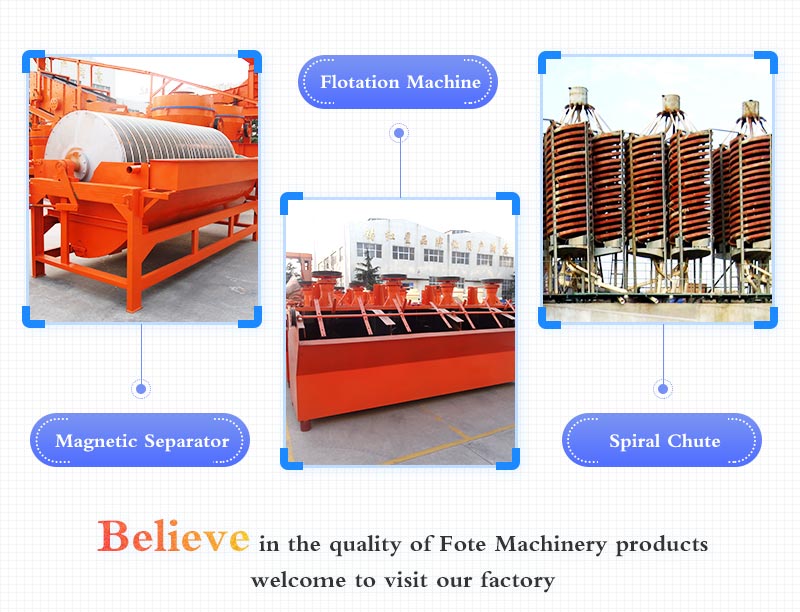
Three kinds of mostly used beneficiation equipment
As mentioned above, magnetic separation, froth flotation and gravity separation are based on different principles, which is the biggest difference between them.
Secondly, their applications are different due to the principles:
Magnetic separation is suitable for the dressing of magnetic minerals, especially iron ores.
Froth flotation is widely used in the separation and cleaning of most ores, especially the purification of sulfide ores.
Gravity separation is mainly used to separate raw materials in which the useful minerals and waste mineral have a large specific gravity difference, such as gold ore, tungsten ore, tin ore and so on.
From the perspective of cost, the equipment cost of gravity separation and magnetic separation is lower, while the cost of flotation is higher than the other two.
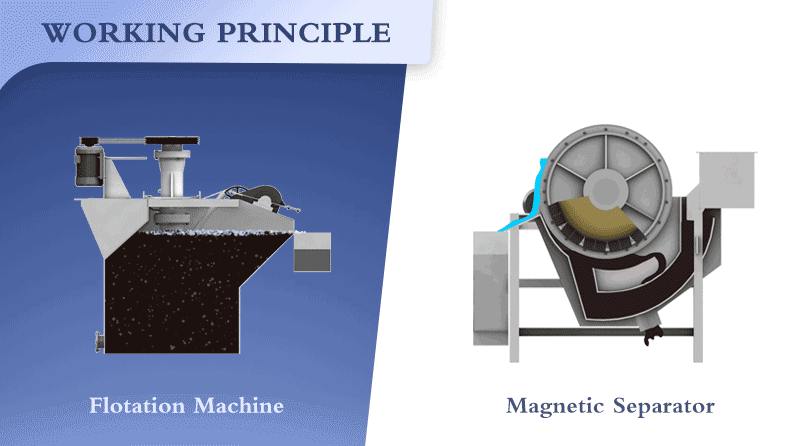
Working principle comparasion of flotation machine and magnetic separator
Magnetic separation can be used in any beneficiation plant to remove or refine magnetic metals.
Magnetic separation completes the beneficiation according to different forces in the magnetic field of the separator. Therefore, different magnetic properties of minerals are an important factor in this process.
The average magnetic strength of the cylinder surface is 100-600mt. According to the processed materials, there are various types of magnetic separators, like downstream, semi-counter-current, counter-current, etc.
| Common Ferromagnetic and Paramagnetic Minerals | |||
| Mineral | Formula | Field Strength (kg) | |
| Ferromagnetic | Magnetic | Fe3O4 | 1 |
| Pyrrhotite | Fe7O8 | 0.5-4 | |
| Paramagnetic | Ilmenite | FeTiO3 | 8-16 |
| Siderite | FeCO3 | 9-18 | |
| Chromite | FeCr2O4 | 10-16 | |
| Hermatite | Fe2O3 | 12-18 | |
| Wolframite | (Fe,Mn)WO4 | 12-18 | |
| Tourmaline | 16-20 | ||
Source: https://en.wikipedia.org/wiki/Magnetic_separation.
Mineral magnetism list of partial materials. If your material is not in it, welcome to contact Fote online engineer for details.
Given the material magnetism, magnetic separator is typically used in iron ore beneficiation plant.
With the example of iron ore magnetic separation in Philippine, a brief introduction to the application of magnetic separator is offered.
The raw material processed in this Philippine iron ore beneficiation plant has a high iron content.
Philippine is rich in iron ore, which is widely distributed in the Zambales Mountains, central Palawan, east Davao, east Misamis, and other areas.
In this iron ore beneficiation plant in Indonesia, the investor chose the high-intensity magnetic separator.
Together with iron ore crushers, ball mill and other equipment, the magnetic separator is used to remove impurities and to separate the fine iron ore.
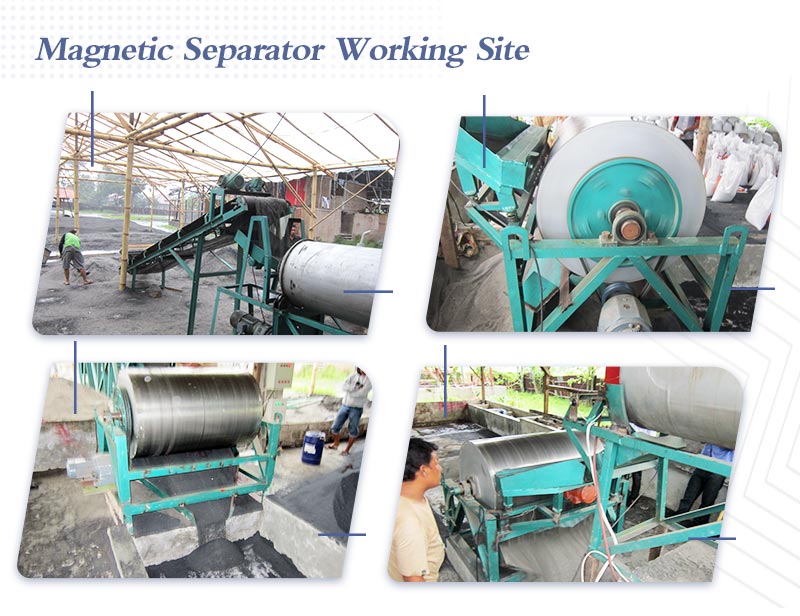
Working site of magnetic separation
The main iron ore dressing process is as follows,
1. Large iron ore is crushed into small pieces by jaw crusher and cone crusher.
2. Then the raw materials are fed into the ball mill for grinding into about 200mesh.
3. After the ball mill, the iron ore powder is beneficiated by high-intensity magnetic separator.
This is a medium and small-scale iron ore beneficiation plant with simple operation and easy machine maintenance.
More importantly, the iron ore gets good beneficiation, grade improved from 35% to about 65%.
| Raw iron ore grade | Grade of fine iron ore | Grade of iron ore tailings | Capacity |
| 35% | Approximately 65% | 5-8% | About 5TPH |
In addition to the purification of ores, magnetic separators, especially high-intensity magnetic separation machines can also be used for the iron removal operations of coal, non-metallic minerals, building materials.
Froth flotation, developed commercially in the 19th century, is the most widely used in these three kinds of beneficiation plants.
Unlike magnetic separation, froth flotation enhances the difference in hydrophobicity between useful minerals and impurities by adding surfactants and wetting agents.
The beneficiation plant is built by this selective separation. Commonly used agents are pine oil, soap, kerosene, resin and so on.
There are two flotation methods commonly used in the flotation market, direct flotation and reverse flotation.
→Direct flotation is a process in which the froth is scraped out with a scraper and the targeted mineral is attached to the foam and collected for further processing.
→Reverse flotation is to collect tailings attached to the foam, leaving the useful minerals for further processing.
As the most widely used beneficiation plant, froth flotation can be used for rough processing and cleaning of more than 90% of minerals.
Froth flotation can select copper ore, zinc ore, lead ore, and other non-ferrous metals. Besides, it can also be used for ferrous metal and non-metallic coarse selection and fine selection.
It is suitable for the beneficiation of fine particles and micro-fine materials. Sometimes, it is difficult to recover the fine ore particles less than 10μm with other processing methods. But froth flotation works.
Froth flotation technology plays an important role in the separation of sulfide.
For example, in Chile, stage grinding and flotation are adopted in the separation of copper sulfide. High-level lime and other chemicals are used as the reagents helping to finish the beneficiation.
This method is also widely used in other beneficiation plants.
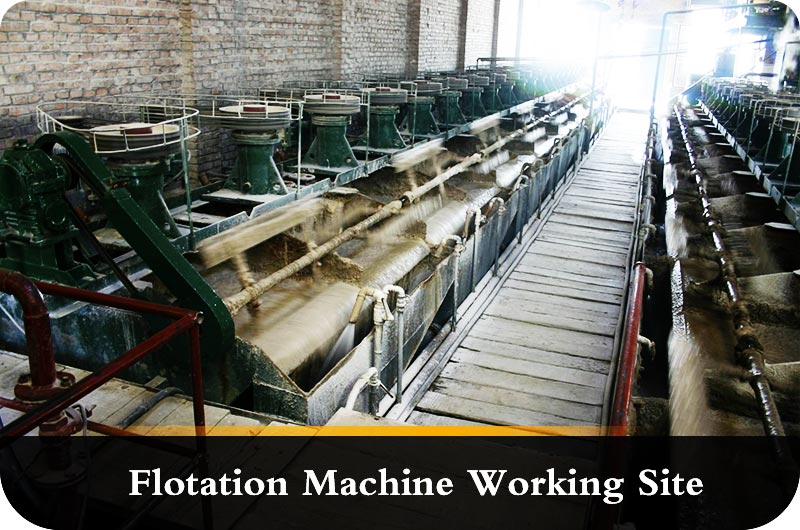
Working site of flotation machine
Similar to the magnetic separation plant, crushers and the ball mill are needed to complete the crushing stage and grinding stage.
Next, the flotation machine is used to finish the beneficiation with flotation reagents. Pulp produced from the flotation machine is dewatered by the rotary dryer and we get the final product.
This investor in Chile chose a suitable copper sulfide flotation machine with the reagents prepared according to the proportion of raw materials by weight.
The copper recovery rate reaches 90%, the copper production rate is about 3.5% and the grade of the final fine copper ore is about 15.8%.
| Copper recovery rate | Copper production rate | Grade of the dressed ore | Capacity |
| 90% | 3.5% | About 15.8% | 5-8TPH |
Froth flotation is regarded as one of the greatest technologies in the beneficiation period.
It plays its role in normal beneficiation plants. What's more, it increases the gradation of finished products from the low-value mineral mixture and makes it an important source of some metals.
Gravity separation is most often used in separation lines with the aid of the large difference in specific gravity between minerals.
At present, the main gravity separation methods are mud-elution by water, hydraulic classification, tabling and so on.
Mud-elution by water is used in the removal of fine mud for industrial sand of glass, casting, etc.
Hydraulic classification is suitable for cleaning casting sand, glass sand, cement standard sand and so on.
Tabling can be used to remove iron and other heavy minerals from glass sand.
In the gravity separation, in addition to the beneficiation equipment, there should be a medium, which can be water or air.
The equipment is structured simply and the cost is lower.
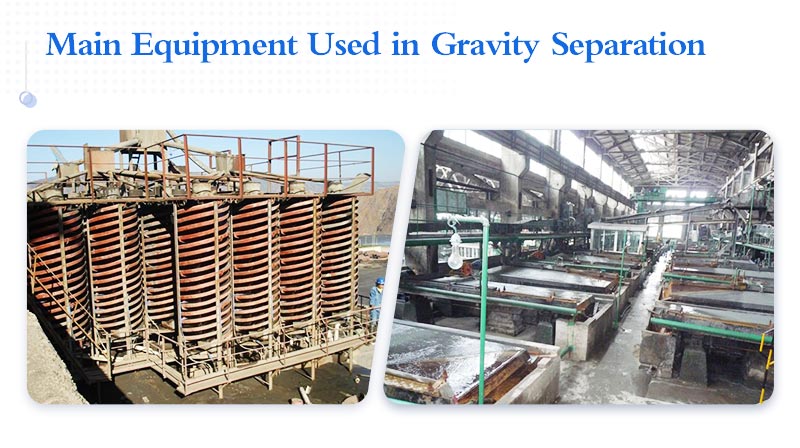
Main equipment used in gravity separation
The most common example of gravity separation is the purification of gold, which has a large specific gravity with a density of 19.6g/m3.
In Tanzania, the shaking table works together with a ball mill and other beneficiation equipment to finish the whole gold ore dressing.
What is used in this gold ore beneficiation plant is 18.5kw ball mill, 1.1kw shaking table, PE-jaw crusher, etc. The transferring medium is liquid.
Wet grinding ball mill is adopted to improve the grinding efficiency. The gold ore powder is got from the ball mill.
After the spiral classifier, the gold ore powder is transferred by the medium to the shaking table.
With gravity separation, the shaking table produces fine gold ore powder.
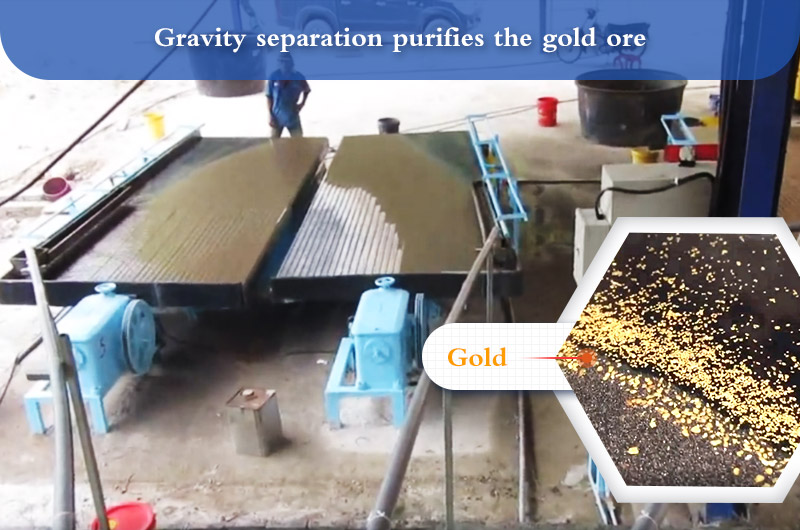
Working site of shaking table in gravity separation plant
As one of the most ancient but mostly used gold ore beneficiation methods, gravity separation wins the status for the easy separation operation and simple structure of the equipment.
In this gold ore beneficiation plant, the gold ore recovery rate reaches approximately 78%, which achieves considerable profits for the investor.
| Grade of raw gold ore | Recovery rate of gold | Capacity |
| 3g/t | About 78% | 3TPH |
Nowadays, instead of process blocks of and coarse grain of materials, gravity separation is also applicable for the fine particles and slime. And combined with centrifugal force and shear force, the separation efficiency is greatly improved.
As the technology developed and the industrial demand increased, today's mineral beneficiation plants not only uses one process but combines two or more processes.
Given the present processing technology, the combination of a variety of processing methods is widely used. The main benefits are as follows,
Taking the combination of these three beneficiation plants as an example here gives a simple process introduction of how to improve the concentrate grade and decrease the tailings grade.
In the separation of iron ore, especially of the low-quality iron ore, using one ore dressing plant will not only increase the pressure of the machine but also increase the tailings grade higher than the expected value.
This issue of low metal recovery rate can be solved by the group of these three beneficiation plants, magnetic separation, froth separation and gravity separation.
Lean iron ore somewhere in Asia as an example has a grade of 30-40% or less. In this beneficiation plant, three kinds of ore dressing methods are combined to improve the efficiency.
The tailing grade by strong magnetic separation often reaches above 17% and the tailing grade produced by froth flotation reaches above 24%. Insufficient depth of ore dressing causes serious metal loss.
If the low-intensity magnetic separator and high-intensity magnetic separator are grouped to finish the first separation. And then the gravity separation plays the role before the secondary separation process by froth separation.
By so, the pressure of the flotation machine is reduced, so does the loss of the micro and fine particle of the iron ore.
Reasonable feed conditions for the next process are provided to achieve efficient emission reduction and remarkable economic benefit.
Generally accepted, one of the challenges facing the mining industry today is how to minimize tailings grade from the limited mineral resources with the most economical and reasonable equipment.
The selection of ore dressing method and beneficiation plant can be judged not only by the name of the material but also by the specific properties of the material, including the different minerals content, specific gravity, hydrophilicity, hydrophobicity, etc.
A beneficiation plant test before the ore dressing equipment investment is necessary. This trial is to help you to understand what kind of magnetic separator you need, and what is the ratio of flotation reagents you need.
If you have no idea what to do, welcome to consult the professional engineers.
 Online Chat
Online Chat